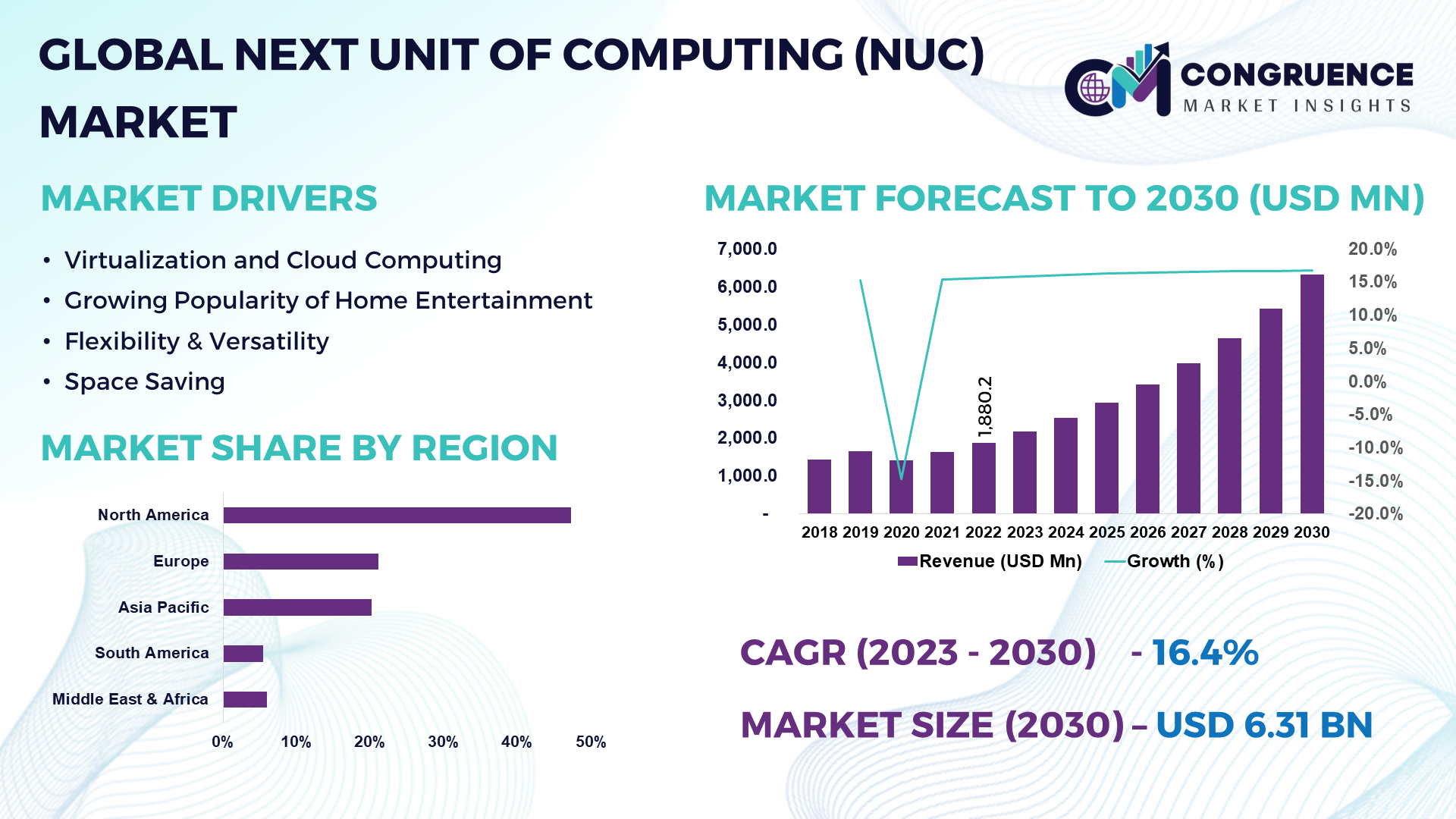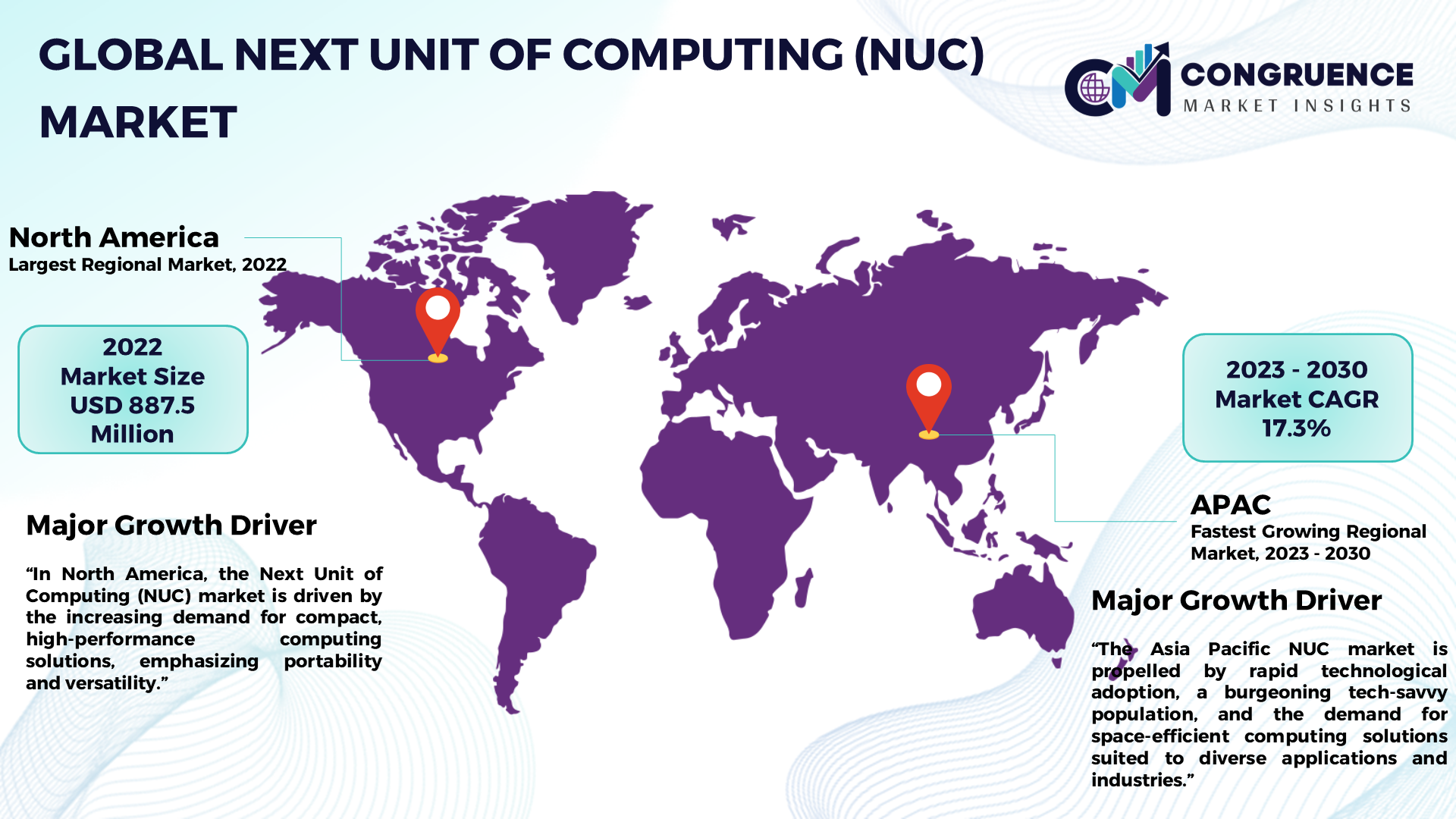Reports
The Global Next Unit of Computing (NUC) Market was valued at USD 1,880.2 Million in 2022 and is anticipated to reach a value of USD 6,312.9 Million by 2030 expanding at a CAGR of 16.4% between 2023 and 2030.
Intel created the Next Unit of Computing (NUC), a compact form factor computer package. It provides a portable and adaptable computing solution by integrating a motherboard and a low-power processor into a tiny chassis. Since NUCs are typically offered as unassembled kits, customers can readily upgrade and configure parts such as RAM, storage, and the operating system to suit their needs. The NUC market had a bright future for a number of reasons. NUCs provide a cost-effective and room-saving substitute for conventional desktop computers as the market for small and lightweight computing solutions grows. The NUC industry was also expanded as a result of the growing popularity of gaming and home entertainment systems, since these small PCs are capable of handling graphics-intensive tasks. Unfortunately, Intel made the announcement that it would be leaving the NUC (Next Unit of Compute) market in July 2023. This implies that the business will not be creating and producing its own range of small PCs. Intel took this choice for a number of reasons, including the fact that the NUC business was minuscule in comparison to the company's other operations, such as the manufacturing of chips and the fact that the mini-PC industry is getting more and more competitive, with many other businesses selling comparable goods.

Next Unit of Computing (NUC) Market Major Driving Forces
Virtualization and Cloud Computing: The need for small, potent computers similar to NUCs is predicted to increase with the growing use of virtualization and cloud computing technologies. Furthermore, since NUCs and similar PCs offer mobility without sacrificing performance, the market for these devices may see further growth due to the growing popularity of remote work and the demand for portable workstations.
Growing Popularity of Home Entertainment: The NUC industry has expanded as a result of the growing popularity of gaming and home entertainment systems, since these small PCs are capable of handling graphics-intensive tasks.
Flexibility & Versatility: Mini-PCs can handle a wide range of user requirements, including light video editing, media streaming, casual gaming, and even standard online browsing and office work. Given their versatility, they may be customized with different operating systems, RAM, and storage to fit different workloads and budgets.
Space Saving: Mini-PCs are an effective and space-saving substitute for conventional desktop computers as the need for small and portable computing solutions grows.
Next Unit of Computing (NUC) Market Key Opportunities
Integration of Advanced Technology: It is anticipated that the incorporation of cutting-edge technologies, such as 5G and artificial intelligence, into small computers, such as NUCs, would create new prospects in a number of industries, including healthcare, retail, and automotive.
Combining Emerging Technologies with Integration: NUCs can use edge computing and AI to serve as gateways for linked devices and smart homes. Virtual experiences and immersive apps can be made possible by integration with AR/VR platforms.
Customization and Personalization: Consumers increasingly seek personalized and customization. Next unit of computing (NUC) manufacturers can offer customization options tailored to tackle specific tasks, such as video editing workstations, AI and machine learning hubs, or cryptocurrency mining rigs. This trend enhances customer engagement and brand loyalty, creating opportunities for premium and niche markets.
Next Unit of Computing (NUC) Market Key Trends
· Compact PCs are becoming a popular option for households and companies due to rising real estate expenses and diminishing workspaces.
· NUCs meet a range of user requirements, including casual gaming, media streaming, and office work in addition to standard web browsing.
· To meet the needs of a wide range of users, NUCs frequently come equipped with several USB ports, HDMI, DisplayPort, Thunderbolt, and Wi-Fi.
· NUCs' form factor has been improved by manufacturers, who are aiming to make them more powerful and compact.
· Regular improvements have been made to NUCs' processor power, graphics capabilities, and general performance.
· There is a trend toward expanding the ecosystem surrounding these compact computer solutions as the NUC industry grows.
Region-Wise Market Insights
North America accounted for the largest market share at 47.2% in 2022 whereas, Asia Pacific is expected to register the fastest growth, expanding at a CAGR of 17.3% between 2023 and 2030.

The Next Unit of Computing (NUC) market reflects different consumer expectations and technology environments through a variety of regional trends. High-performance NUCs are in high demand in North America due to the region's strong emphasis on cutting-edge technology as well as the popularity of gaming and content creation. In Europe, concerns about environmental sustainability are typically aligned with the pursuit of a balance between energy efficiency and compact form factors. The Asia-Pacific region, which is renowned for having a consumer population that is tech aware, demonstrates an increasing interest in small computing solutions for use in both home and office settings. Furthermore, NUCs can be tailored to certain area preferences owing to strategic partnerships with regional manufacturers. Meanwhile, growing interest in the creation of digital infrastructure is reflected in emerging nations' increasing desire for affordable yet potent NUCs. All things considered, consumer inclinations, regional alliances, and technology developments all influence the geographical dynamics of the NUC industry.
Market Competition Landscape
There are numerous producers and retailers in the highly competitive global next unit of computing (NUC) market. These companies compete in the market through a range of strategies, such as joint ventures, mergers and acquisitions, and product innovation. The sizable contracts they land for the use of their NUC technology serve as evidence of their market development. These developments show how the industry has changed and how committed big businesses are to advancing the science of next-generation computing (NUC). Many new competitors have joined this industry using innovation and development strategies in an attempt to establish a reputation for themselves. They have expanded the range of products they sell, invested in state-of-the-art sound sensors, and focused on improving efficiency and scalability. In spite of this, the market is dominated by the top companies in the sector because of their broad experience, devoted clientele, effective distribution networks, and ongoing R&D investments. Some of the top businesses in the industry are:
· Apple
· Asus
· Gigabyte Technology
· MSI (Micro-Star International)
· ZOTAC
· Dell
· Lenovo
· Shuttle Inc.
· HP (Hewlett-Packard)
· Acer
· Alienware (a subsidiary of Dell)
· ECS (Elitegroup Computer Systems)
· AOpen
· Raspberry Pi Foundation
· Giada Technology
Apple is a well-known innovator in the consumer electronics sector and is widely recognized for its cutting-edge products. With the release of its Mac mini lineup, Apple has made notable strides in the NUC market in recent years. The corporation offers a wide range of products, such as smartphones, laptops, and desktop computers. Lenovo is a multinational technology business that creates, produces, and markets a variety of goods, including NUCs. With its small and potent devices, it has made a name for itself as one of the top companies in the NUC market. Lenovo's robust distribution network, competitive pricing, and ongoing innovation are responsible for the company's global expansion. Furthermore, its 2005 acquisition of IBM's personal computer division greatly strengthened its position in the market.
|
Report Attribute/Metric |
Details |
|
Market Revenue in 2022 |
USD 1,880.2 Million |
|
Market Revenue in 2030 |
USD 6,312.9 Million |
|
CAGR (2023 – 2030) |
16.4% |
|
Base Year |
2022 |
|
Forecast Period |
2023 – 2030 |
|
Historical Data |
2018 to 2022 |
|
Forecast Unit |
Value (US$ Mn) |
|
Key Report Deliverable |
Revenue Forecast, Growth Trends, Market Dynamics, Segmental Overview, Regional and Country-wise Analysis, Competition Landscape |
|
Segments Covered |
By Performance (High-Performance NUCs, Mid-Range NUCs, Entry-Level NUCs) By Application (Commercial Application, Industrial Application, Education and Government Applications, Others) By Wireless Connectivity (Wi-Fi Enabled NUCs, Bluetooth Enabled NUCs, Cellular Connectivity NUCs) |
|
Geographies Covered |
North America: U.S., Canada and Mexico Europe: Germany, France, U.K., Italy, Spain, and Rest of Europe Asia Pacific: China, India, Japan, South Korea, Southeast Asia, and Rest of Asia Pacific South America: Brazil, Argentina, and Rest of Latin America Middle East & Africa: GCC Countries, South Africa, and Rest of Middle East & Africa |
|
Key Players Analyzed |
Apple, Asus, Gigabyte Technology, MSI (Micro-Star International), ZOTAC, Dell, Lenovo, Shuttle Inc., HP (Hewlett-Packard), Acer, Alienware (a subsidiary of Dell), ECS (Elitegroup Computer Systems), AOpen, Raspberry Pi Foundation, Giada Technology |
|
Customization & Pricing |
Available on Request (10% Customization is Free) |
